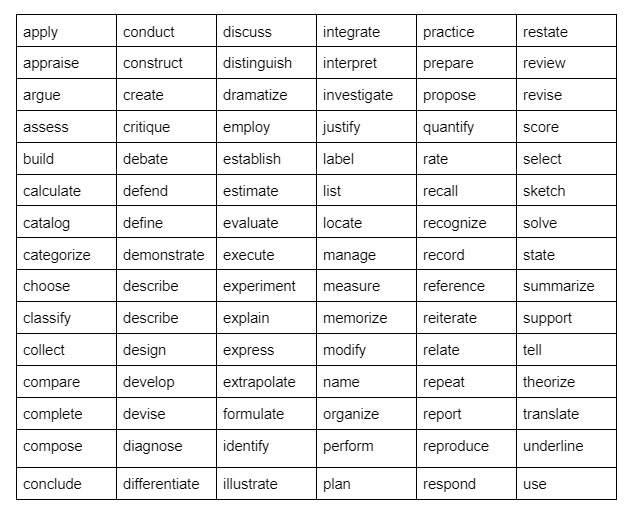Learning Outcomes are the key factor in driving more people into your course and increasing the client base.
How are simple learning outcomes able to do that? Easy, because they provide purpose and motivation to study. More on what are those, how to write effective learning outcomes, and what verbs to use you can read in this article.
So, if you are ready, let's start!
The following article covers:
Learning Outcomes vs. Learning Objectives?
What are learning outcomes?
Learning outcomes are an essential part of coaching and education in general. They give the teacher a direction and structure of the course, and they give hints of the practical use of the course to those who want to learn.
To define learning outcomes, we should look at them from the learner's perspective. Learning outcomes are a set of achievements that describe the result of an educational experience. They state what students will know, how they will think, and what they will be able to do after participating in a seminar or completing a course.
There are things that teachers use to state the desirable results of the education, and there is the current intellectual state of the learner. Learning outcomes close the gap between the two.
Not only that, but they help customers with choosing a course, giving a clue what your educational material is about and how it will influence them.
Because there is always the danger of misunderstanding that comes directly from miscommunication, say you don't write the learning outcomes of your course in the advertising sheet or syllabus. You and the customer can have completely different ideas of the results, and the latter can be disappointed by not getting what they wanted. Why would you care? Well, they can criticize you on the net and draw away possible new customers if they are not driven away by the lack of information about your course in the first place.

5 types of learning outcomes
Now that we have identified what learning outcomes are, let's see if we can classify them. One of the major characteristics of learning outcomes is that they are somewhat quantifiable. It will be easier for you to come up with learning outcomes for your own course if we distinguish the salient features of each type. We divided learning outcomes into five categories: intellectual skills, cognitive strategies, verbal information, motor skills, and attitude.
- Intellectual skills: Intellectual skills describe the ability to understand how to do something. That is, basically, knowledge. Say you are giving a yoga seminar. Intellectual skills here would be how to do a certain pose.
- Cognitive strategy: Cognitive strategies are a bit different from intellectual skills, though they are often confused. Cognitive skills are about learning how to think in a certain way and how to approach tasks from the point of view of the given profession. It is how to work with new information using past experience. Going along with the yoga seminar, it is creating a brand new yoga pose using the principles of yoga.
- Verbal information: It concerns the ability to replicate the knowledge that was examined during the lecture. It is whether a person knows how to explain the material in an understandable and organized way. For example, a person had a lecture about quantum mechanics. Can they explain it to somebody who doesn't know anything about quantum mechanics in a way that they will understand? If yes, then a verbal information outcome has been achieved.
- Motor skills: Motor skills are the ability to perform a thing physically and perfect skills through practice. If a person who took an art course can draw and can perfect their drawing style through time and practice, that is a motor skill outcome.
- Attitude: Attitude outcome describes the student's internal state; it is how new knowledge, skills, and experience have changed the person's psyche. The course in yoga could make the student more mindful, relaxed, and happy, for example.
Learning Outcomes vs. Learning Objectives?
There is a need to clear one thing up the difference between learning outcomes and learning objectives because people use them as synonyms and think that it is the same thing. Learning outcomes and objectives describe two different aspects of the learning process, but they are, of course, connected. Let's see why there is a need to distinguish between both of them according to certain criteria:
- POV: The learning objective is more teacher-centric, while the outcome is student-oriented. The first one answers the question of why the course was created in the first place, and the second – how it will benefit the student.
- Continuum: An objective is a prediction; it is what may happen, the desired result. An outcome here concerns things that have been done already – what the student will do after they learn.
- Goal: A learning objective is connected with the purpose of the learning activity: "This course is for explaining the concept of distillation," for example. On the other hand, an outcome concerns what students will be able to do – replicate the process of distillation and make something out of it, in this case.
- Scale: A learning outcome is very narrow, very specific. A learning objective, although measurable, is wide and abstract.
5 steps to write effective learning outcomes
Being a coach as you probably are, you don't want to spend too much time writing a little part in your course syllabus or your coaching website, do you? We suggest you use this little guide on writing learning outcomes that will work to ease your task.
Step 1 - Understand the importance to be efficient
First things first, you should understand that this thing that you're writing is not just for your students. It benefits you in the first place. You get to recognize what your course is about; maybe you get more excited and realize that your course develops important skills and creates an impact.
Secondly, of course, it benefits your students. It clears everything for them. Understanding the importance will make you take this process seriously. For the sake of the structure of your course and for its purpose, we recommend going along with the next steps.
Step 2 - Taking look at Bloom's taxonomy
Along with others, Benjamin Bloom published Taxonomy of Educational Objectives in 1956. The taxonomy contained six main categories: knowledge, comprehension, application, analysis, synthesis, and evaluation, each of which contained sub-categories and verbs.
Now, Bloom's original taxonomy was a bit too static, so a group of scholars revised the thing in 2001 and made it more dynamic, deepening the concept and dividing knowledge into different types: factual, conceptual, procedural, and metacognitive. Bloom's taxonomy, we dare say, will help you a LOT with coming up with ideas for your learning outcomes. Plus, it has a lot of verbs that you can use according to our next trip.

Step 3 - Starting with action verbs
Now, this is important to remember: a learning outcome always begins with a verb. Do not write "A student will be able to…" — no. Start with an action verb and a very specific one.
Verbs such as "know" and "learn" are too abstract. Now, this is where Bloom's taxonomy comes into play: it has a lot of specific verbs that are classified according to ability. Remember to use the classification of learning objectives into intellectual skills, motor skills, etc., that we noted earlier. An example of a specific action verb is "apply".
Step 4 - Follow up with a statement
The statement comes immediately after the verb. It describes the specific concepts and skills that one will learn after completing your course. For example, going along with the verb "apply" that we picked above, we can create this outcome: "Apply knowledge of physical properties of organic compounds to compose fuels." A few tips to remember about statements or learning outcomes in general:
- Be specific: As you can see in the example that we used, the statement should be narrow, discrete, and concrete. It has to be illustrative, something that you can easily imagine.
- Do not underestimate or overestimate the learning outcomes of your course: It's the same "don't lie in your resume because it will backfire" concept. If you overestimate your outcomes, your students will be disappointed, to say the least. If you underestimate the outcomes of your coaching sessions, you may lose possible customers. So be cautious and careful with this; you want to find the middle.
- Do not confuse learning outcomes with objectives: As we noted previously, there are a few significant differences between learning outcomes and objectives. Mixing the two can lead to confusion and misunderstanding.
Step 5 - Practice
Despite your best beliefs and efforts, you won't be able to conduct good learning outcomes on the first try. As with anything else in life, it will come with practice. So when you start designing the outcomes for your course, don't rush to make it final. Treat it as a first draft, give it a few hours, and then come back and try again. You can also practice by designing outcomes for hypothetical courses. Another way to approach this is to find a course with learning outcomes, design your own outcomes for that course, and then read the original outcomes and compare them to yours. This will show you what you're doing wrong.
Learning outcomes examples
Let's say you are a lifestyle coach who offers a course on "How to level-up your life."
Your possible learning outcomes can be:
- Identify our strengths and weaknesses
- Identify the level we are at right now, and satisfaction from 12 main aspects of life
- Identify top priorities in life
- Develop Emotional Intelligence
- Develop essential skills required for being more self-aware
- Control over emotions
- Develop growth mindset
A yoga instructor can come up with another set of learning outcomes:
- Develop a fit and well-trained body
- Demonstrate a set of skills concerning strength, flexibility, and balance
- Identify breathing patterns and techniques
- Perform different yoga positions in a sequence
- Enable taking control over crippling anxiety and stress
- Develop healthy lifestyle
- Become mindful and get in balance with your soul
What if you want to teach a course in Russian literature? We got you covered there, too:
- Differentiate between genres of literature
- Replicate important themes that are found in Russian literature like poverty, greed, and moral
- Identify famous Russian authors of different centuries and subgenres
- Summarize the plots and main ideas in the most important pieces of literature specific to Russian tradition
- Develop critical thinking abilities
- Recap the history of Russian literature and of the most famous authors
- Widen the vocabulary
Learning outcomes verbs
Some very common verbs to use when writing learning outcomes are:

Finalizing
There you go – a complete guide to learning outcomes.
In this article, we identified what learning outcomes are – statements that describe the results of learners after they experience learning – and their main characteristics which include measurability, contextualism, learner-centric.
We divided them into five groups: intellectual skills, cognitive strategies, verbal information, motor skills and attitude. Learning outcomes should not be confused with learning objectives; the latter are, unlike the former, subject-centered, future-oriented and discrete.
To create a set of learning outcomes, one should understand their efficiency first, and then consult Bloom’s taxonomy which is a great tool, a little cheat-note of a sort. An effective and strong learning outcome starts with a specific action verb that is directly followed by a statement.
The probability of writing a good learning outcome from the first try is low, but don’t be discouraged. Everything will come with practice, and our examples of learning outcomes and action verbs will help you with that.


![How to Start Online Coaching Business [Proven Strategies]](https://d35v9chtr4gec.cloudfront.net/uteach/articles/LXoil0HbCqKEO2lAdpzG-1693384984/start-online-coaching-business.jpg)
